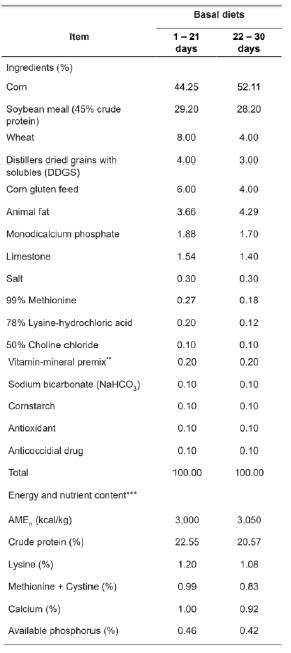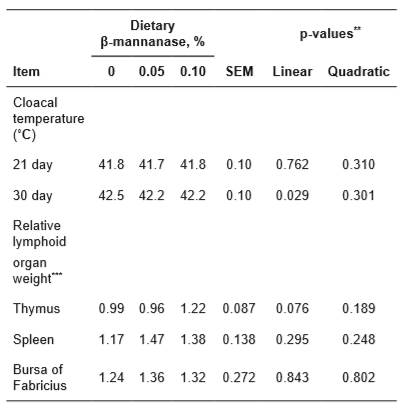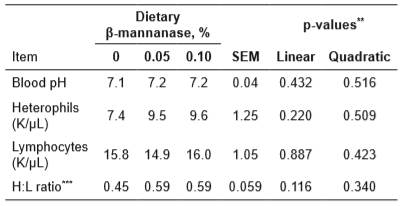Introduction
Nonstarch polysaccharides (NSPs) are considered anti-nutritional factors (ANFs) in poultry diets by increasing digesta viscosity, which is often associated with decreased nutrient digestibility (Mussini et al., 2011; Shastak et al., 2015). Furthermore, NSPs are not digested in the small intestine, passing to the hindgut of poultry. Therefore, diets high in NSPs may increase hindgut fermentation leading to increased heat production (Jósefiak et al., 2004; Choct et al., 2010). Low dietary levels of NSPs or its increased utilization could decrease total heat production of poultry (Nian et al., 2011), which could be of benefit on heat-stressed poultry raised under hot climatic conditions.
Dietary β-mannan is one of the main NSPs in poultry diets (CVB, 1998). Dietary β-mannanase, which is an exogenous enzyme that hydrolyses β-mannans, has been reported to decrease the anti-nutritional effects of β-mannans, and thus, improve animal productivity (Kong et al., 2011; Kwon and Kim, 2015; Shastak et al., 2015). Similar improvements in the utilization of dietary NSPs by exogenous NSP-degrading enzymes have been widely observed in broiler chickens (Bhuiyan and Iji, 2015; Abdollahi et al., 2016). These positive effects of dietary β-mannanase may also result in decreased heat loads of poultry by lowering fermentative heat production in the hindgut, which leads to a decrease in heat stress if the poultry is raised under hot climatic conditions. However, the efficacy of dietary β-mannanase on broiler chickens raised under hot climatic conditions has not been investigated.
Therefore, the present experiment was conducted to investigate the effects of dietary β-mannanase on growth performance, cloacal temperature, relative lymphoid organ weight, and blood characteristics of broiler chickens raised under hot climatic conditions.
Materials and methods
Ethical considerations
All experimental procedures were reviewed and approved by the Animal Care and the Use Committee at Chung-Ang University (IACUC No.: 2016-00108).
Animals and experimental design
A total of 1,701 1-day-old Ross 308 broiler chickens were obtained from a local hatchery (Yangji Hatchery, Pyeongtaek, Republic of Korea). All chicks were housed in conventional floor pens (200 × 230 × 100 cm; width × length × height for each pen). All chicks were randomly allotted to one of three dietary treatments with nine replicates consisting of 63 chicks per replicate. A two-phase feeding program with a starter diet from 0 to 21 days and a grower diet from 22 to 30 days was used in the experiment (Table 1). A basal diet for each growing phase was prepared. All nutrients and energy requirements in the basal diet met or exceeded the nutrient recommendations by the NRC (1994) for broiler chickens. Dietary β-mannanase (CTCZYME; declared activity of 800,000 unit/kg, CTCbio Inc., Seoul, Republic of Korea) was added to the basal diet at inclusion levels of 0.05 or 0.10% at the expense of cornstarch. The experimental diets were in a mash form. All birds were provided free access to feed and water throughout the experiment. The experiment lasted for 30 days, covering a hot season of South Korea, from mid-July to the middle of August. Average room temperature was 28.8 ± 1.74˚C and average relative humidity was 76.4 ± 11.49% during the experiment.
Table 1 Composition and nutrient content of basal diets (as-fed basis). *

*β-mannanase was included in the diet by replacing the same amounts of cornstarch. **Provided per kilogram of the complete diet : vitamin A: 12,500 IU; vitamin D3: 2,500 IU; vitamin E: 20 IU; vitamin K3: 2 mg; vitamin B1: 2 mg; vitamin B2: 5 mg; vitamin B6: 3 mg; vitamin B12: 18 µg; folic acid: 1 mg; biotin: 50 µg; niacin: 24 mg; zinc: 60 mg; manganese: 50 mg; iron: 50 mg; copper: 6 mg; cobalt: 250 µg; iodine: 1 mg; selenium: 150 µg. ***Calculated values (National Research Council, 1994); AMEn: nitrogencorrected apparent metabolizable energy.
Measurements
The detailed procedure for measuring growt performance of broiler chickens was reported previously (Kim et al., 2017). In short, body weight (BW) and feed intake (FI) were recorded at the end of the experiment to calculate body weight gain (BWG) and feed conversion ratio (FCR). Cloacal temperature was determined by inserting a digital thermometer (Omron Healthcare Korea Co., Ltd., Seoul, Republic of Korea) 3 cm into the cloaca of four birds per replicate, randomly selected on days 21 and 30 of the experiment. At the end of the experiment, three birds per replicate with a BW close to the mean BW of the replicates (i.e., 27 birds per treatment) were euthanized by cervical dislocation. Lymphoid organs (namely, thymus, spleen, and bursa of Fabricius) were harvested and weighed. Relative lymphoid organ weights were calculated as lymphoid organ fresh weight (mg)/chicken BW (g) before slaughter (Liu et al., 2014). Blood samples were collected by heart puncture using serum vacutainer tubes and blood pH was measured using blood pH meters (Hanna instruments, Woonsocket, RI, USA). Blood samples for leukocyte profile examination also were collected into EDTA-coated tubes, and the examination was performed immediately with a veterinary blood analyzer (HEMAVET 950FS, Cumbria, UK). The heterophil:lymphocyte ratio (H:L ratio) was used as a stress indicator, and calculated by dividing the number of heterophils by the number of lymphocytes (Gross and Siegel, 1983).
Statistical analysis
All data were tested for normal distribution and outliers with the UNIVARIATE procedure of SAS (SAS Institute Inc., Cary, NC, USA). No outliers were identified. Afterwards, all data were analyzed by ANOVA in a completely randomized design using the PROC GLM procedure (SAS Institute Inc., Cary, NC, USA). Each replicate was considered as an experimental unit in all data analyses (n=9 pertreatment). The LSMEANS procedure was used to calculate treatment means. The orthogonal polynomial contrast test was performed to determine linear and quadratic effects of increasing inclusion levels of β-mannanase in diets on each measurement (Seo et al., 2018). Significance and tendency for statistical tests were set at p<0.05 and 0.05≤p≤0.10, respectively.
Table 2 Effects of dietary β-mannanase on growth performance of broiler chickens raised under hot climatic conditions*.

*Data are least squares means of nine replicates per treatment. **Orthogonal polynomial contrast test for increasing inclusion levels of dietary β-mannanase. FCR: Feed conversion ratio.
Results
Growth performance
The effects of dietary β-mannanase on growth performance of broiler chickens raised under hot climatic conditions are presented in Table 2. During the experiment, increasing inclusion levels of dietary β-mannanase had no effects on final BW, BWG, FI, and FCR.
Cloacal temperature and relative weight of lymphoid organs
The effects of dietary β-mannanase on the cloacal temperature and relative lymphoid organ weight are presented in Table 3. Cloacal temperature measured at 21 days of age was not affected by inclusion levels of β-mannanase; however, cloacal temperature measured at 30 days of age was decreased (linear, p<0.05) with increasing inclusion levels of β-mannanase. Regarding relative lymphoid organ weight, inclusion levels of β-mannanase tended to increase (linear, p=0.076) relative weight of thymus, but had no effects on relative weight of spleen and bursa of Fabricius.
Blood characteristics
Blood pH was not affected by dietary inclusion levels of β-mannanase (Table 4). Increasing inclusion levels of β-mannanase did not affect total number of heterophils and lymphocytes. Stress index, expressed in H:L ratio, was not influenced by the inclusion levels of β-mannanase.
Table 3 Effects of dietary β-mannanase on cloacal temperature and relative lymphoid organ weight of broiler chickens raised under hot climatic conditions*.

*Data are least square means of nine replicates per treatment. **Orthogonal polynomial contrast test for increasing inclusion levels of dietary β-mannanase. ***Relative lymphoid organ weight was calculated as lymphoid organ fresh weight (mg)/chicken body weight (g) before slaughter.
Table 4 Effects of dietary inclusion of β-mannanase on blood traits of broiler chickens raised under hot climatic conditions*.

*Data are least square means of nine replicates per treatment. **Orthogonal polynomial contrast test for increasing dietary inclusion levels of β-mannanase. ***The heterophil:lymphocyte (H:L) ratio was used as a stress index, calculated by dividing the number of heterophils by the number of lymphocytes (Gross and Siegel, 1983).
Discussion
As a NSPs-degrading enzyme, β-mannanase catalyses the random hydrolysis of the β-1,4- mannosidic linkages in β-mannans (McCleary, 1988). Hydrolysis of β-mannans in broiler diets can decrease its anti-nutritive effects by reducing the viscosity of digesta, thus, increasing nutrient utilization, especially in the upper part of the gastrointestinal tract (GIT; Hussain et al., 2012; Lee et al., 2018). Accordingly, some studies have indicated that dietary β-mannanase improves growth performance of broiler chickens (Jackson et al., 2004; Cho and Kim, 2013), whereas other studies showed no beneficial effects (Ouhida et al., 2002). In the present experiment, dietary inclusion of β-mannanase had no effects on broiler performance. However, positive effects of β-mannanase in previous experiments cannot be directly compared with those observed in the present study, because the former experiments raised broiler chickens under thermoneutral conditions. The reason for our broiler performance results is not clear. To the best of our knowledge, no reports have evaluated the efficacy of dietary β-mannanase in broiler chickens raised under hot climatic conditions. Jackson et al. (2004) stated that the positive effects of β-mannanase are associated with a reduction of digesta viscosity, thus improving energy metabolism. Although not measured in this study, it appears that reduction in digesta viscosity and possible improvement in energy metabolism by β-mannanase were too little to improve growth performance of broilers.
Several experiments have been conducted to find effective nutritional regimens for mitigating heat stress on broiler chickens, such as dietary inclusion of zinc (Barlet and Smith, 2003), tocopherol (Niu et al., 2009), probiotics, and prebiotics (Sohail et al., 2012). However, inconsistent results have been reported to date. In the present experiment we hypothesized that dietary β-mannanase could decrease heat loads in broilers raised under hot conditions because it could decrease the amount of fermentable materials in the GIT, therefore reducing fermentative heat production. This hypothesis was partly confirmed: there was a decrease of cloacal temperature at 30 days of age by feeding β-mannanase. However, cloacal temperature measured at 20 days was not affected by dietary β-mannanase. This was probably due to differences in body temperature and FI between both ages. However, decreased cloacal temperature from β-mannanase supplementation was not associated with improved broiler performance. Apparently, the extent of reduction in cloacal temperature was too small to affect performance. Furthermore, the reason for the small reduction in cloacal temperature by dietary β-mannanase could be the relatively small proportion of heat from intestinal fermentation compared with the total heat production in broilers (Józefiak et al., 2004).
Lymphoid tissues play a vital role in avian immunity. The lymphoid system consists of the central (i.e., bursa of Fabricius and thymus) and peripheral (i.e., spleen, lymph nodes and bone marrow) lymphoid organs (Davison et al., 2008). Thus, the relative lymphoid organ weight is often considered as a measure of immunity in poultry (Pope, 1991). It was reported that relative lymphoid organ weight decreases in broiler chickens exposed to heat stress, indicating decreased immunity (Quinteiro-Filho et al., 2010). Dietary β-mannanase has been reported to act as a possible immune stimulator because mannanoligosaccharides, produced from β-mannan degradation in the GIT, improve the immune response in animals (Zou et al., 2006). Likewise, Zangiabadi and Torki (2010) reported that β-mannanase increased antibody responses to Newcastle vaccination in broiler chickens. In addition, Jackson et al. (2003) reported that β-mannanase decreased pathogenic lesions in the GIT of broilers challenged with Eimeria spp. and Clostridium perfringens. In the present experiment, we observed a tendency for increased relative weight of thymus with increasing inclusion of β-mannanase. This result agrees with Zou et al. (2006) who reported that dietary β-mannanase increases the relative weight of thymus of broiler chickens. On the other hand, Zangiabadi and Torki (2010) reported that β-mannanase have no effects on the relative weight of thymus, bursa of Fabricius, and spleen under thermoneutral conditions, although the antibody responses to Newcastle vaccination were affected by β-mannanase. It is not clear why the changes in relative lymphoid organ weight in response to β-mannanase varied with environmental temperature; however, it could be related to different immune responses and stimulation of broilers raised under different thermal conditions.
Blood pH is often increased in poultry raised under heat stress because increasing panting behavior increases bicarbonate loss (Borges et al., 2004). However, we found no significant effects of β-mannanase on blood pH of broilers raised under hot climatic conditions. In addition, blood H:L ratio is often used as a stress index in poultry exposed to various stressors, including heat stress (Gross and Siegel et al., 1983). In the present study, however, the H:L ratio in the blood was not affected by dietary β-mannanase. These results could reflect a very small change in body temperature of broilers fed β-mannanase.
In conclusion, dietary β-mannanase decreases cloacal temperature and increases relative thymus weight of broiler chickens raised under hot climatic conditions. However, these beneficial effects do not directly influence growth performance of broiler chickens raised in hot conditions.














